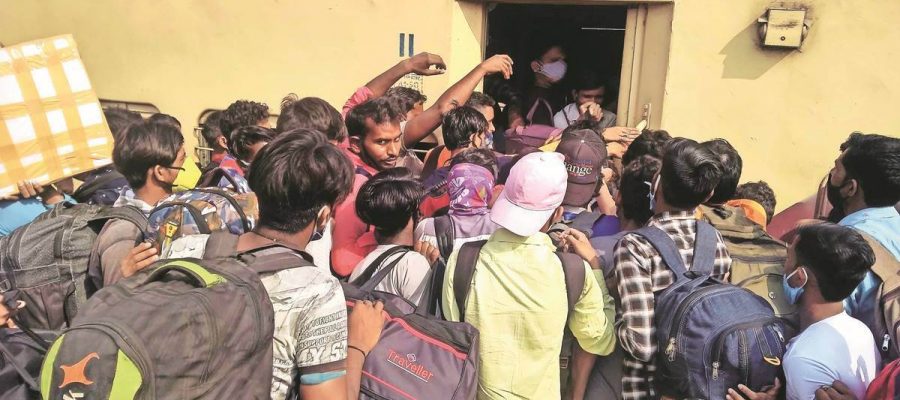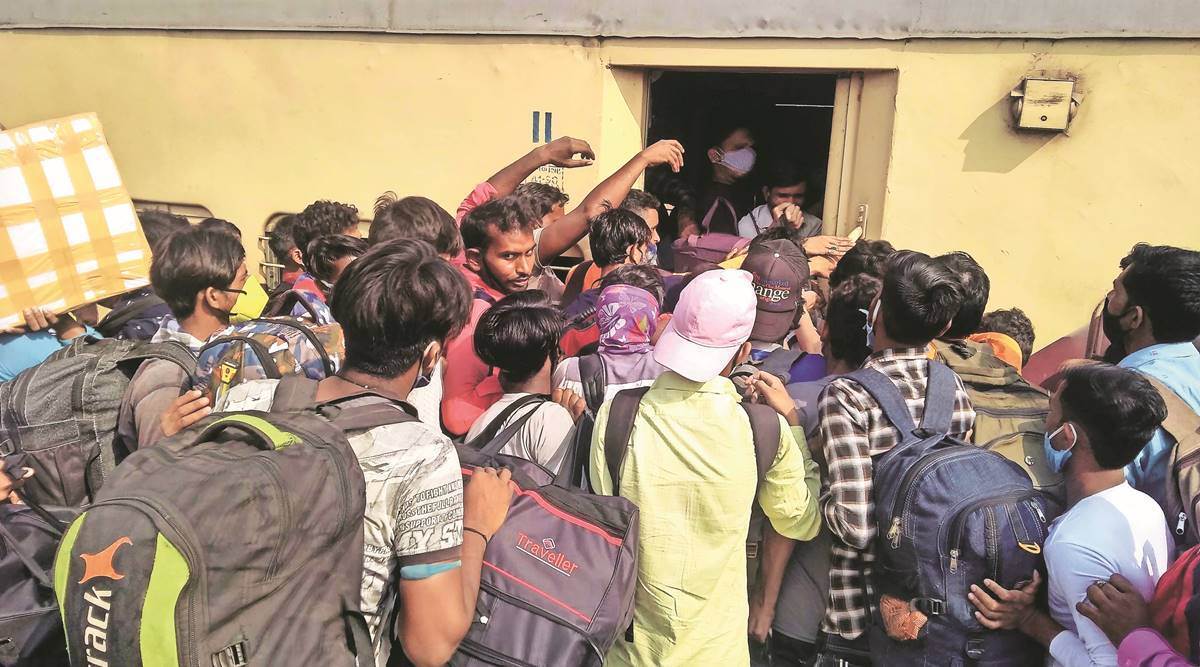A whole year of uncertainty and deprivation, of constantly adapting to shocks and new realities, has left India’s informal workforce in an economically and emotionally brittle condition
As the second wave of the COVID-19 pandemic takes India in a deathly grip, images of returning migrants crowding transport terminals in large cities like Delhi and Mumbai have returned to our television screens. But whereas last year’s long walk home by migrants was triggered by the economic shock of losing livelihoods and compounded by the stringent mobility restrictions of the nationwide lockdown, this year’s return to the villages seems a relatively well thought strategy of exit from cities that are failing to serve even those with wealth and connections. While they continue to mistrust the state, a year of dealing with uncertainties may have improved migrants’ ability to anticipate shock and respond with deliberation and agency.
Last year’s lockdown starting March 25 was implemented overnight, in a top-down manner, across the entire country. Diverse factors, including the sudden loss of income, mounting debt and the fear of the disease, coalesced to set off what anthropologist Biao Xiang calls “shock mobilities”, simply understood as sudden movements that respond to acute disruptions. The absence of public transport and the sealing of state borders placed an immediate and severe constraint on all mobilities, including those that were essential for the survival of the urban poor, including migrant labour who need to travel within the city or across locations in order to access adequate employment, or return to home base. In doing so, it created a wave of uncertainty and panic that triggered dangerous means of escape similar to those used by refugees and asylum seekers, like walking long distances or engaging the services of illegal and expensive private transporters.
In the past year, migrant workers have made considered choices about whether to stay or return. In many migrant households, male members have made forays into the city to test opportunities, while women and children remained behind. Many made multiple back and forth trips, as opportunities in the city waxed and waned. Another set of migrant households — usually those with long-term work relationships in the city — chose to remain in their villages for months and returned only when their contacts in the city assured them of the availability of work and housing. Construction, brick kiln and agriculture workers restarted their seasonal migration cycles as soon as contractors rehired them. Workers have constantly leveraged (im)mobility to maximise employment opportunities and cut back on costs of survival.
But a whole year of uncertainty and deprivation, of constantly adapting to shocks and new realities, has left India’s informal workforce in an economically and emotionally brittle condition. Despite the inordinate attention of the media and development community on issues of migrants and informal workers, little has changed on the ground for them.
An economic recovery in fits and starts has meant inadequate work and lower wages. The jury is still out on how well the social protection system has delivered. Additional employment created at source villages by bolstering the MGNREGA programme has provided little succour. Cash transfers and additional rations via the PDS have been helpful, but short-lived, and indebtedness has risen dramatically.
These experiences appear to have prepared migrant workers to face the second wave. Their actions this year seem driven, not so much by desperation, as by their ability to strategically weigh their options. Last year, they suspected the government would not come to their rescue. This year, they know that the system is too overwhelmed to heed their need for cash, food and healthcare. The government’s response in the second wave is also distinct from last year. Dispersed mini-lockdowns, instead of a centralised one, have meant open state borders and accessible public transport, allowing migrants a planned exit instead of panic flight.
This planned exit appears to be driven by a clear rationale, the pros and cons of which are examined against the backdrop of anticipated state action that controls mobility and impacts livelihoods, that is, lockdowns. First, exit is an economic strategy to avoid further debt from mounting costs of food and housing rent in the city, in the face of uncertain incomes. For instance, migrants in Delhi and Mumbai left after collecting March-end salaries, amid rumours of impending lockdowns. Concurrently, pro-active cash transfers by state governments in Maharashtra and Delhi might have delayed exit decisions for some, providing urgent sustenance when they needed it.
Second, it is an emotional response. Migrants remain scarred by memories of last year’s arduous journeys home and this time round, may be more fearful of health risks. Falling sick could mean loss of work and further debt, but also a lurking fear of death. Migrant labour cannot hope to access an overburdened health system that even the well-off are struggling to negotiate.
A third experience from last year, which migrants would have taken on board, is the increased likelihood of accessing welfare mechanisms including employment opportunities under MGNREGA and increased PDS allocations if they are back in their home villages. The practical ineffectiveness of portability mechanisms is well understood by migrant communities. That migrants from Uttar Pradesh and West Bengal returned home to vote in local and state elections, despite a raging pandemic, only underscores the absolute importance of being politically relevant in source locations.
The planned exit of migrants from the city in the wake of Covid-19’s second wave in India, therefore, simply adds on to the continued (im)mobilities through a year of constant uncertainty and struggle. Rapidly changing rules, uneven economic recovery and a still broken social security system do not inspire any faith in either the state or the market.
By all accounts, migrants fully understand that with lower bargaining power at work and no political commitment towards systemic inclusion, the city remains a hostile place. Correspondingly, mobility — the proverbial aana jaana — remains a strategy to absorb the city’s dual character as both opportunity and threat, while the idea of home as a place of retreat — albeit imperfect — is reinforced. A post-Covid imagination of sustainable development must account for the importance of various forms of mobility as a strategy of resilience for the country’s poor.
This article first appeared in the print edition on May 1, 2021 under the title ‘The second leaving’.
The writer is Fellow, Centre for Policy Research. Her work focuses on understanding the links between internal migration and urbanisation in the Indian context.
Source: Read Full Article


